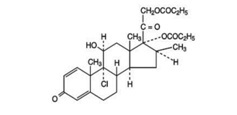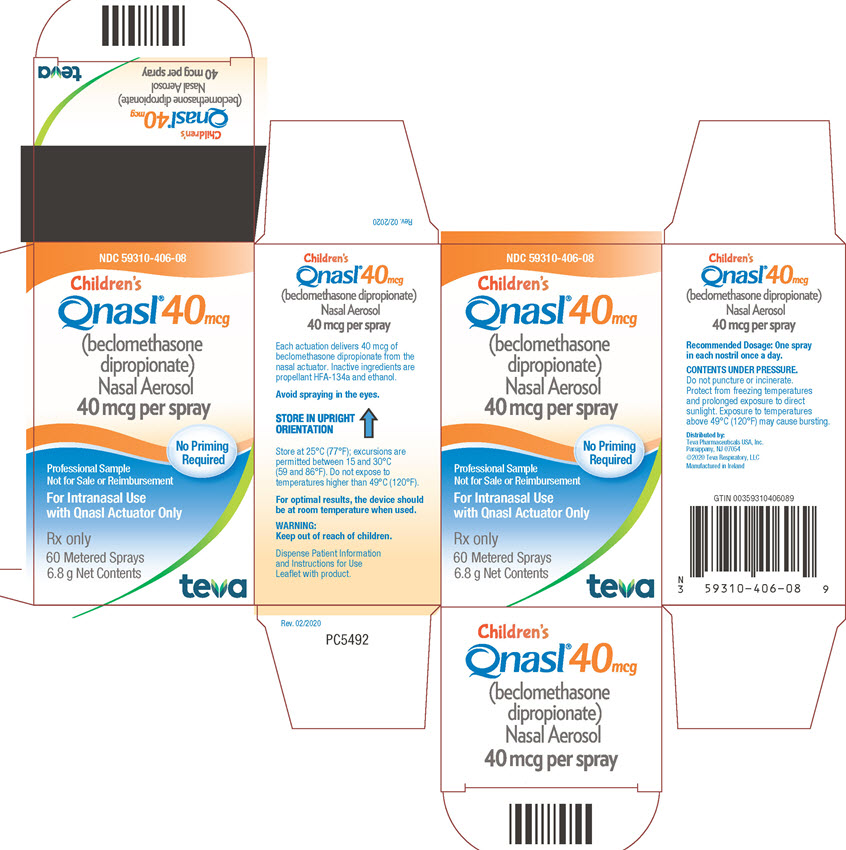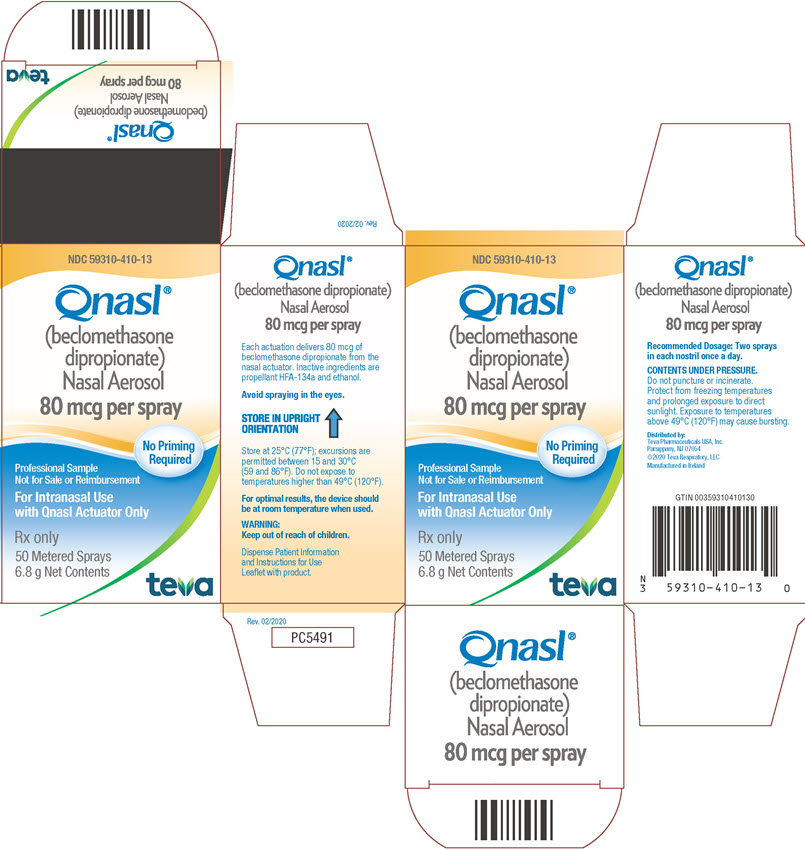Qnasl
Generic name: beclomethasone nasal
Brand names: Beconase AQ, QNASL
Drug class: Nasal steroids
Medically reviewed by A Ras MD.
What is Qnasl?
Qnasl Nasal Aerosol is a prescription medicine that treats seasonal nasal and year-round nasal allergy symptoms in children 4 years of age and older and adults. It is not known if Qnasl Nasal Aerosol is safe and effective in children under 4 years of age.
Description
Beclomethasone dipropionate USP, the active component of QNASL Nasal Aerosol, is an anti-inflammatory steroid having the chemical name 9-chloro-11β,17,21-trihydroxy-16β-methylpregna-1,4-diene-3,20-dione 17, 21-dipropionate and the following chemical structure:

Beclomethasone dipropionate, a di-ester of beclomethasone (a synthetic corticosteroid chemically related to dexamethasone), is a white to almost white, odorless powder with a molecular formula of C28H37ClO7 and a molecular weight of 521.1. It is practically insoluble in water, very soluble in chloroform, and soluble in acetone and in dehydrated alcohol.
QNASL Nasal Aerosol is a pressurized, nonaqueous solution in a metered-dose aerosol device intended ONLY for intranasal use. It contains a solution of beclomethasone dipropionate in propellant HFA‑134a (1,1,1,2‑tetrafluoroethane) and dehydrated ethanol. QNASL 40 mcg Nasal Aerosol delivers 40 mcg of beclomethasone dipropionate from the nasal actuator and 50 mcg from the valve. QNASL 80 mcg Nasal Aerosol delivers 80 mcg of beclomethasone dipropionate from the nasal actuator and 100 mcg from the valve. Each strength delivers 59 mg of solution from the valve with each actuation. Each QNASL 80 mcg Nasal Aerosol canister contains 10.6 g of drug and excipients and provides 120 actuations. Each QNASL 40 mcg Nasal Aerosol canister contains 6.8 g of drug and excipients and provides 60 actuations.
Mechanism of Action
Beclomethasone dipropionate is a prodrug that is extensively converted to the active metabolite, beclomethasone-17-monopropionate. The precise mechanism through which beclomethasone dipropionate affects rhinitis symptoms is unknown. Corticosteroids have been shown to have multiple anti-inflammatory effects, inhibiting both inflammatory cells (e.g., mast cells, eosinophils, basophils, lymphocytes, macrophages, and neutrophils) and the release of inflammatory mediators (e.g., histamine, eicosanoids, leukotrienes, and cytokines).
Beclomethasone-17-monopropionate has been shown in vitro to exhibit a binding affinity for the human glucocorticoid receptor which is approximately 13 times that of dexamethasone, 6 times that of triamcinolone acetonide, 1.5 times that of budesonide and 25 times that of beclomethasone dipropionate. The clinical significance of these findings is unknown.
What is the most important information I should know about Qnasl?
Qnasl Nasal Aerosol is available in 2 different strengths:
- Qnasl Nasal Aerosol 40 mcg is only for use in children 4 years to 11 years of age and should be given under the supervision of a parent, guardian or caregiver.
- Qnasl Nasal Aerosol 80 mcg is only for use in adolescents and adults 12 years of age and older.
Who should not take Qnasl?
Do not use Qnasl Nasal Aerosol if you or your child is allergic to beclomethasone dipropionate or any of the ingredients in Qnasl Nasal Aerosol. See the end of this leaflet for a complete list of ingredients in Qnasl Nasal Aerosol.
What should I tell my healthcare provider before taking Qnasl?
Before using Qnasl Nasal Aerosol, tell the healthcare provider about all of your medical conditions, including if you or your child:
- has had recent nose problems such as nasal sores, nasal surgery, or a nasal injury.
- has or have had eye problems, such as blurred vision, increased pressure in their eye (glaucoma) or cataracts.
- has tuberculosis or any untreated fungal, bacterial, or viral infections, or eye infections caused by herpes.
- has not had or been vaccinated for chickenpox or measles.
- is pregnant or plans to become pregnant. It is not known if Qnasl Nasal Aerosol will harm an unborn baby. Talk to the healthcare provider if you or your child is pregnant or plans to become pregnant.
- is breastfeeding or plans to breastfeed. It is not known if Qnasl Nasal Aerosol passes into breast milk. Talk to the healthcare provider about the best way to feed the baby if you or your child is using QNASL Nasal Aerosol.
Tell the healthcare provider about all of the medicines you or your child takes, including prescription and over-the-counter medicines, vitamins, and herbal supplements.
Qnasl Nasal Aerosol and other medicines may affect each other and cause side effects. Qnasl Nasal Aerosol may affect the way other medicines work, and other medicines may affect the way Qnasl Nasal Aerosol works.
Especially tell the healthcare provider if you or your child takes other corticosteroid medicines.
Ask the healthcare provider for a list of these medicines if you are not sure.
How should I take Qnasl?
- Qnasl Nasal Aerosol 40 mcg is only for use in children 4 years to 11 years of age and should be given under the supervision of a parent, guardian or caregiver.
- Qnasl Nasal Aerosol 80 mcg is only for use in adults and adolescents 12 years of age and older.
- Read the step-by-step Instructions for Use at the end of this leaflet for specific information about the right way to use Qnasl Nasal Aerosol.
- Qnasl Nasal Aerosol is for use in the nose only. Do not spray it in your eyes or mouth and do not let your child spray it in their eyes or mouth.
- Use Qnasl Nasal Aerosol exactly as the healthcare provider tells you or your child to use it. Do not use more of your medicine or use it more often or let your child use more of the medicine or use it more often than the healthcare provider tells you.
- Qnasl Nasal Aerosol does not need to be primed.
- Qnasl Nasal Aerosol 40 mcg:
- contains 60 sprays, and
- has a spray counter which initially should read 60 sprays, and counts down each time a spray is released
- Qnasl Nasal Aerosol 80 mcg:
- contains 120 sprays, and
- has a spray counter which initially should read 120 sprays, and counts down each time a spray is released.
- Do not use the Qnasl Nasal Aerosol after the spray counter reads 0. You or your child may not get the right amount of medicine.
- The usual dose of Qnasl Nasal Aerosol:
- 40 mcg is 1 spray in each nostril, 1 time a dayfor children who are 4 years to 11 years of age. Your child should not use more than a total of 2 sprays per day.
- 80 mcg is 2 sprays in each nostril, 1 time a day for adolescents and adults 12 years of age and older. You should not use more than a total of 4 sprays per day.
You and your child will get the best results if they keep using Qnasl Nasal Aerosol regularly each day. If you or your child’s symptoms do not improve or get worse, call the healthcare provider.
What are the possible side effects of Qnasl?
Qnasl Nasal Aerosol may cause serious side effects, including:
- nose bleeds or nasal ulcers. The healthcare provider should check the inside of you or your child’s nose (nasal mucosa) for problems during treatment with Qnasl Nasal Aerosol. Talk to the healthcare provider if the nose bleeds or has nasal ulcers.
- fungal infections (thrush) in the nose, mouth, or throat. Tell the healthcare provider if you or your child has any redness or white colored patches in the mouth or throat.
- slow wound healing. You or your child should not use Qnasl Nasal Aerosol until the nose has healed if there was a sore in the nose, if you or your child had surgery on the nose, or the nose has been injured.
- eye problems. If you or your child has had glaucoma, cataracts or blurred vision in the past, you or your child should have regular eye exams while using Qnasl Nasal Aerosol. Tell the healthcare provider if you or your child has any change in vision during treatment with Qnasl Nasal Aerosol.
- serious allergic reactions. Stop using Qnasl Nasal Aerosol and call the healthcare provider right away or get emergency medical help right away if you or your child get any of the following signs and symptoms of a serious allergic reaction:
- hives
- swelling of your lips, tongue or face
- rash
- breathing problems
- immune system effects and a higher chance for infections. Tell your or your child’s healthcare provider about any signs or symptoms of infection such as:
- reduced adrenal function (adrenal insufficiency). Adrenal insufficiency can happen in people who take higher doses of Qnasl than recommended over a long period of time. Symptoms of adrenal insufficiency may include:
- slowed growth in children. Children should have their growth checked regularly while using Qnasl Nasal Aerosol.
The most common side effects with Qnasl Nasal Aerosol 40 mcg in children who are 4 years to 11 years of age include:
- headache
- fever
- upper respiratory tract infection
- pain or swelling of your nose or throat (nasopharyngitis)
The most common side effects with Qnasl Nasal Aerosol 80 mcg in adults and adolescents 12 years of age and older include:
- nasal discomfort
- headaches
- nose bleeds (epistaxis)
Tell the healthcare provider if you or your child has any side effect that bothers you or that does not go away.
These are not all the possible side effects of Qnasl Nasal Aerosol. For more information, ask the healthcare provider or pharmacist.
Call your healthcare provider for medical advice about side effects. You may report side effects to FDA at 1-800-FDA-1088.
General information about the safe and effective use of Qnasl
Medicines are sometimes prescribed for purposes other than those listed in a Patient Information leaflet. Do not use QNASL Nasal Aerosol for a condition for which it was not prescribed. Do not give Qnasl Nasal Aerosol to other people, even if they have the same symptoms that you or your child has. It may harm them.
You can ask your pharmacist or healthcare provider for information about Qnasl Nasal Aerosol that is written for health professionals.
How should I store Qnasl?
- Store Qnasl Nasal Aerosol at room temperature between 68˚F to 77˚F (20˚C to 25˚C).
- Do not puncture the Qnasl Nasal Aerosol canister.
- Do not store the Qnasl Nasal Aerosol canister near heat or a flame. Temperatures above 120˚F (49˚C) may cause the canister to burst.
- Do not throw the Qnasl Nasal Aerosol canister into a fire or an incinerator.
- Safely throw away medicine that is out of date or no longer needed.
Keep Qnasl Nasal Aerosol and all medicines out of the reach of children.
What are the ingredients in Qnasl?
Active ingredient: beclomethasone dipropionate
Inactive ingredient: propellant HFA-134a and dehydrated ethanol
Label
40 MCG SAMPLE CARTON DISPLAY PANEL

- NDC 59310-406-08
- Children’s Qnasl® 40 mcg
- (beclomethasone diproprionate)
- Nasal Aerosol 40 mcg per spray
- No Priming Required
- Professional Sample Not for Sale or Reimbursement
- For Intranasal Use with Qnasl Actuator Only
- Rx only
- 60 Metered Sprays
6.8 g Net Contents - TEVA
80 MCG SAMPLE CARTON DISPLAY PANEL

- NDC 59310-410-13
- Qnasl®
- (beclomethasone diproprionate)
- Nasal Aerosol 80 mcg per spray
- No Priming Required
- Professional Sample Not for Sale or Reimbursement
- For Intranasal Use with Qnasl Actuator Only
- Rx only
- 50 Metered Sprays
6.8 g Net Contents - TEVA
SRC: NLM .
